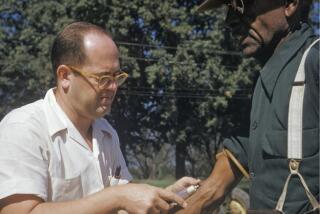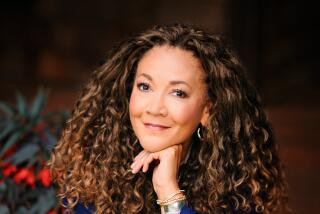How TV News Promotes Anti-Black Stereotyping : Media: Local stations need to be more conscious of how they may inadvertently contribute to modern racism.
- Share via
The success of David Duke, as well as coded racial signals employed by more respectable politicians, testifies to the persistent appeal of racism in American politics. While the roots of racism are varied and deep, there is a surprising source of messages that daily stimulate racial tension: local television news.
More popular in most metropolitan areas than network news, the primary news source for perhaps a plurality of Americans, local TV contributes to a subtle but very real pattern of anti-black stereotyping. That is the conclusion of my detailed study of more than 200 local news shows in Chicago. Evidence from viewing local news in 12 other major markets, such as New York, San Francisco and Washington, suggests that similar practices may be common throughout urban America.
Blacks generally look more threatening than whites in crime stories, and they seem more demanding and self-serving in political stories. Further, the presence of black journalists on the programs might reinforce whites’ tendency to deny that discrimination still impedes African-Americans.
These three messages parallel the three components of what scholars call “modern” racism. According to such social scientists as David Sears of UCLA, only small minorities of whites still openly espouse the genetic inferiority of blacks or the desirability of legally enforced segregation.
Instead, the more widely held racist attitudes now have three themes: negative emotional feelings toward blacks, outright rejection of blacks’ political agenda and denial that discrimination lingers. I believe that local TV’s often-sensationalized news of crime reinforces whites’ emotional hostility, that its coverage of politics promotes whites’ rejection of blacks’ policy goals and that its high-visibility black anchors and reporters suggest, ironically, that bigotry is a thing of the past.
The study found, for example, that blacks accused of violent crimes were significantly more likely than whites so accused to be shown in the physical grasp of police officers: 38% compared to 18%. And blacks accused of violence were less likely than whites to have their names displayed with still photos: 49% to 65%. Symbolically, then, blacks seem more dangerous, more in need of physical restraint, yet are given less individual identity.
To be sure, television’s contribution to modern racism is unintentional and rooted mainly in larger societal problems. The news images sometimes reflect class bias, or the reality of the disproportionate number of poor, young black males involved in crime. Whites charged with newsworthy crimes are more likely to be middle class, to make bail and have a lawyer as a spokesman. So their images on television are more favorable.
Further, blacks involved in politics reliably generate the drama and conflict television thrives on. TV would rather show a shouting head than a talking head any time. So in political stories, TV news depicts blacks as more demanding, emotional and self-seeking than whites. By one measure, local news made blacks seem 10 times more insistent on special government favors than whites.
The skewed imagery, with white politicians motivated primarily by altruism and blacks by selfishness, is again rooted in social reality. Since whites already dominate the power structure, their political representatives need only defend the status quo in general terms, for example, by invoking the public interest or nonracial values such as low taxes. Blacks, long excluded from the Establishment, have to make explicit demands for power and for change.
Many of the racial messages on local news are difficult to change, since they reflect a part (but only a part) of urban reality. And certainly hiring black journalists is not a bad thing. But local news needs to be more conscious of how its programs may inadvertently contribute to modern racism. For example, stations could work harder to ensure equivalent imagery of black and white accused criminals.
It’s not that blacks and whites are treated differently in every respect; many of the study’s measurements were in balance. But, overall, local television presents viewers with an accumulation of negative imagery of African-Americans. By denying the historical context of high crime rates and political demands among blacks--the residue of long years of discrimination--television contributes to a racism that is more subtle than old-fashioned bigotry, but just as destructive, especially in today’s tense economic and political climate.
More to Read
The complete guide to home viewing
Get Screen Gab for everything about the TV shows and streaming movies everyone’s talking about.
You may occasionally receive promotional content from the Los Angeles Times.






